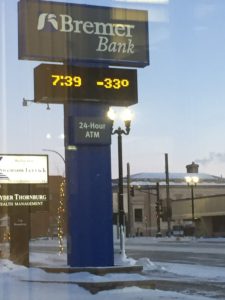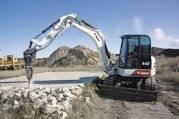Throwback Thursday — Cold weather and the burial business

Actual air temperature in my home community last week. That is not windchill. . .it is “actual” temperature
Editor’s Note: I happen to be on vacation this week. And, when you are from Minnesota, you take vacation in a warm weather climate. Just for a little throwback to last year at this time, I happened to be on my vacation from Minnesota when the Polar Vortex got stuck over the state. And, I was glad to be gone. However, the cold temperatures did remind me of what we used to call in Minnesota “Spring burials”. Here’s last year’s article about the process of burials in extremely cold weather.
Angie and I returned from a couple of weeks hiatus to a warm weather climate on Saturday. While we were gone, the polar vortex moved south into Minnesota where our community saw its coldest temperatures in about 20 years. First off, I was glad to be gone during the time period, but secondly it reminded me of a time in Minnesota, and probably other frozen tundra states, where such things as “Spring burials”, as they were known, were common. This article that I found in Canada’s Recorder and Times also reminded me, not so fondly, of the days of Spring burials.
When I started in the funeral business in north central Minnesota almost all people who died in January, February, and March were stored in their caskets for later burial in the Spring when the ground had thawed out. A few things came together to cause earth burial in the winter difficult.
- The ground was frozen
- Snow covered the ground making grave locations difficult
- The physics that heat rises and cold air moves down.
Those three combinations caused burial, especially in small church cemeteries with no full-time staff, very difficult. The ground was frozen and that is pretty simple to comprehend — for those of you who have never witnessed frozen ground it is concrete like in hardness. Snow covering the graves is also a simple problem when you think of having at least 18 inches of snow cover and then a volunteer cemetery sexton trying to find the four corners of a grave so that it actually gets dug in the exact right spot. Even when a grave could be located it was hard to “soften” simply because of the physics of heat rising. I mention the “physics” thing because we tried lots of remedies to soften the ground including lighting charcoal on the ground and/or putting a grave thawing machine on the ground for 48 hours. While these methods eventually did soften the  ground, it would never be total because the heat you generated moved up not down.
ground, it would never be total because the heat you generated moved up not down.
What would happen with Spring burials is that the casketed bodies would be stored in cemetery “storage vaults” — small buildings constructed of

Backhoe with pneumatic drill
stone or concrete on the cemetery property. Those casketed bodies would be placed in there after after the funeral and come April – and always before Memorial Day- the funeral home, the family, and the clergy would select a day to inter the body in what was referred to as a “Spring Burial”.
Think about the staffing and the ramifications of a funeral home that did about 200 casketed deaths — that was us in those days. The law of averages would indicate we would have about 50 spring burials annually. So, in the 8 weeks between April 1 and Memorial Day we had to schedule 50 burials in addition to our regularly scheduled services. And. . . . everybody wanted the burial to be on Saturday so that families could attend. Our modus operandi was to schedule about 6 burials per Saturday (don’t forget that families had a say when theirs was scheduled) using two teams. Each would do three burials. . say at 11am, 1 pm, and 3 pm. Each team needed a hearse and a funeral director (Minnesota law requires a licensed funeral director at a casketed burial) at each burial. This process tied up two hearses every Saturday even before we started scheduling “at need” funerals.
This process started Friday for us as on Friday we had to go to the storage vaults and take the caskets out one by one using a hearse or removal vehicle and bring them to the funeral home. Here they were dusted, the identification papers attached to each casket were checked and and the casket was readied for the next day’s burial. On Saturday, a burial would take place and the team would go back to the funeral home to load up the next one. It was a busy time for gravediggers and clergy too.
The practice started to wane in Minnesota as pneumatic drills or jackhammers became common equipment on the backhoes that were used for digging graves. The operator would be able to chip or jackhammer the first couple of feet just like concrete until they were down past the frozen earth – in some cases 2 to 4 feet – to “dig” the rest of the grave.
There are still some small communities in Minnesota where “Spring burials” continue to be practiced. Even though, in most cases, it is not necessary today, it became a tradition in some of those communities that they continue to follow. Actually, in Minnesota now, by law a family has the right to require the cemetery to dig a grave for an at need funeral. For me, I’m glad Spring burials are pretty much over around here and I try to remember back to how our staff made it thru those Friday and Saturdays.
[wpforms id=”436″ title=”true” description=”true”]





















MN law states that the cemetery “shall, as far as possible,” provide winter burials. As you pointed out, this is not as easy as some people believe. It is not a guaranteed right to have a winter burial.